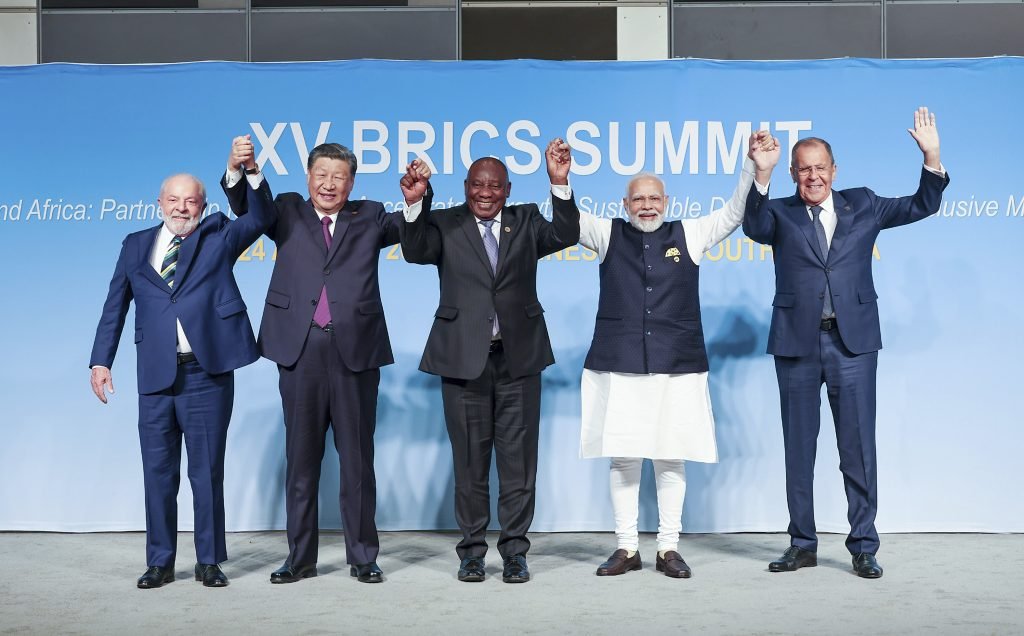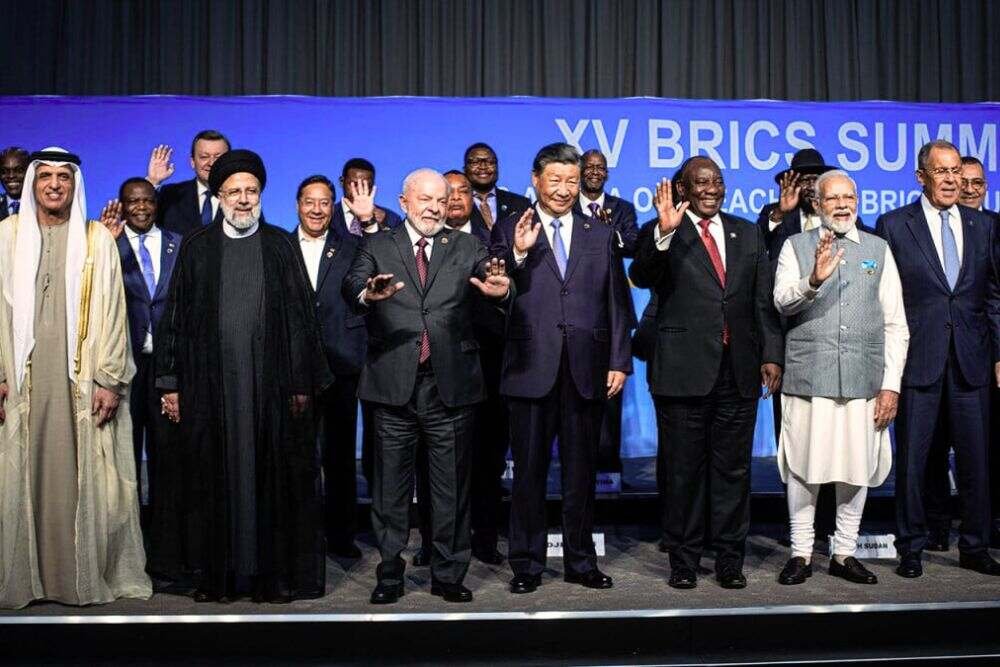Why BRICS Members 2025 are Increasing: Explore Hot Updates! Who’s In and What’s Next?

Why BRICS Members 2025 are Increasing: Explore Hot Updates! Who’s In and What’s Next?
What happens when emerging economies unite to challenge the established global order? Millions have been asking this question since the formation of the BRICS+ bloc. To understand this fully, exploring its origins and the latest developments shaping its rise is essential. That is precisely what this post will uncover.
In 2025, the BRICS alliance, originally comprising Brazil, Russia, India, China, and South Africa, expanded its reach and influence. Recent inclusion of BRICS new members, such as Egypt, Ethiopia, Iran, Saudi Arabia, and the United Arab Emirates, has further strengthened this global alliance. BRICS now represents approximately 46% of the world’s population and accounts for about 30% of global GDP.
This expansion is not merely about numbers. It is now a strategic move to amplify the voice of the Global South in international affairs. The addition of resource-rich and geopolitically significant nations enhances BRICS’s capacity to influence global trade, energy markets, and financial systems.
As BRICS members grow, questions arise about their future trajectory and the implications for existing global institutions. Will this expanded coalition redefine the rules of international engagement, or will internal diversities challenge its cohesion?
BRICS at a Turning Point: Why 2025 Matters
As we enter 2025, the BRICS nations have become much more than just a group of five countries. The recent admission of Egypt, Ethiopia, Iran, Saudi Arabia, and the UAE has genuinely strengthened the bloc. Now, the alliance is growing in both size and global influence.
Key Developments:
- Trade in Local Currencies: A Clear Shift Is Happening. BRICS countries are starting to trade more in their currencies to reduce dependence on the U.S. dollar. For example, in 2024, 90% of Russia’s trade with other BRICS members was done in local currencies.
- BRICS Pay System: To support this change, the group introduced BRICS Pay, a new system that makes cross-border payments easier using local currencies. It is also a step toward reducing reliance on older systems like SWIFT.
- Digital Currency Exploration: While the U.S. has paused work on its digital dollar, BRICS countries are actively exploring digital currencies through their central banks to strengthen their financial systems and independence.
- Challenges in Unity: Despite progress, not everything runs smoothly. At a recent meeting in Rio, the BRICS foreign ministers were unable to agree on a joint statement. It shows that internal disagreements are still an obstacle.
BRICS Expansion 2024–2025: Who Joined and Why
In 2024, BRICS took a significant step by expanding its membership beyond the original five nations. The BRICS nations started this alliance, transforming into BRICS after South Africa joined in 2010.
After 2010, it was the first time the bloc sent invitations to new countries to join the alliance. Several joined as permanent members, and some joined as partners. This move was not just about numbers; it also signals a bold push to reshape global influence.
Who Joined in 2024?
Six countries were invited to the 2023 summit in Johannesburg. As of early 2024, these nations have officially joined as BRICS members 2024.
- Egypt
- Ethiopia
- Iran
- Saudi Arabia
- United Arab Emirates
Argentina was also invited but later declined due to internal political and economic concerns. The recent president pulled out of the alliance, hinting that it is not in their nation’s interests now.
Why These Countries?
The new members were not chosen randomly. Each brings something valuable to the table:
- Oil & Energy Power: Saudi Arabia, Iran, and UAE are the top oil producers, strengthening BRICS as a global energy bloc.
- Strategic Geography: Egypt links Africa to the Middle East, while Ethiopia is a growing East African hub.
- Economic Diversity: These countries add new markets, trade routes, and financial strength.
What is Next in 2025?
More countries had shown interest, including Indonesia, Nigeria, and Bangladesh. Indonesia officially joined the bloc in January 2025. According to the president of South Africa, more than 20 countries are in line to join the bloc.
This expansion is not just about adding flags. It is about creating a stronger voice for the Global South—and reducing dependence on Western-led institutions like the IMF or World Bank.
Cultural Exchange and People-to-People Connections
BRICS countries have increasingly prioritized cultural exchanges and people-to-people relationships as core components of their cooperation. Initiatives such as the BRICS Network University and regular BRICS cultural festivals facilitate a deeper mutual understanding among citizens.
Programs for youth exchanges and academic partnerships further strengthen social connections within BRICS. These initiatives not only foster cultural awareness but also reinforce the unity and collaborative spirit central to BRICS’ ongoing success.
How BRICS Members Now Shape Global GDP and Trade

August 23, 2023, Johannesburg, Gauteng, South Africa: Left to right: Brazilian President Luiz Inacio Lula da Silva, Chinese President Xi Jinping, South African President Cyril Ramaphosa, Indian Prime Minister Narendra Modi and Russian Foreign Minister Sergey Lavrov pose for the group photo at the 15th BRICS Summit, August 23, 2023 in Johannesburg, South Africa. (Credit Image: © Prime Minister’s Office/Press Inf/Planet Pix via ZUMA Press Wire
The BRICS group is growing in size and gaining serious ground in global economics. Adding new countries to the BRICS members’ list has turned this alliance into a heavyweight force that is hard to ignore on the world stage.
Let us break it down.
Economic Power in Numbers
- As of 2025, BRICS nations contribute around 35% of global GDP when measured by purchasing power parity (PPP). That is more than the G7, which stands at roughly 30%.
- The group also has nearly 45% of the world’s population, giving it unmatched potential in consumer markets and labor power — a scale that even influences seasonal marketing strategies, from retail promotions to crafting targeted Labor Day email templates for global audiences.
Trade and Export Influence
- China leads as the world’s top exporter.
- Russia, Saudi Arabia, and Iran dominate global energy exports, especially in oil and gas.
- Brazil and India are massive producers of agricultural goods and IT services.
- UAE and South Africa are critical in logistics, as well as rare minerals and metals.
Together, this mix makes BRICS a self-reliant bloc in many sectors, such as energy, food, technology, and raw materials.
Health Cooperation and Pandemic Response Strategies
In the aftermath of COVID-19, health cooperation among BRICS nations has significantly intensified. The establishment of the BRICS Vaccine Research and Development Centre in 2022 marks a milestone, enabling joint vaccine development and shared production facilities.
Additionally, BRICS members coordinate pandemic preparedness strategies, pooling medical technologies, healthcare innovations, and epidemiological data to strengthen collective response capabilities.
Initiatives such as India’s expansive telemedicine networks and Russia-China collaborations in remote healthcare solutions underline a robust BRICS commitment to enhancing healthcare resilience and readiness against future global health threats.
BRICS Countries’ Share in Global Food Production
BRICS members share a large part of the global grain requirements. With several Asian and African countries, and most importantly, Brazil, BRICS has an upper hand in agriculture.
| Category | Top BRICS Contributors | Share in Global Production |
| Sugar Cane | Brazil, India, China | Around 66% (two-thirds) |
| Maize (Corn) | China, Brazil | Nearly 30% |
| Rice | China, India | Over 50% |
| Wheat | China, India, Russia | More than 40% |
| Oil Palm Fruit | Indonesia, Malaysia, Thailand (new BRICS partners) | bout 90% |
| Potatoes | China, India | Nearly 40% |
| Chicken (Poultry) | China, Brazil | More than 20% |
| Pork | China | Over 40% |
| Beef | Brazil, China | Over 20% |
| Seafood (Aquaculture) | China, India, Indonesia | Over 70% combined |
| Hen Eggs | China | 34% (alone) |
Why It Matters
With more members, BRICS now covers key supply chains and global demand hubs. It is not just a club of emerging markets anymore. It is becoming a parallel economic system. It offers developing nations a seat at the decision-making table and less dependence on the U.S. dollar or Western trade routes.
Influence on Digital Currency and Fintech Developments
BRICS actively promotes innovation in digital currency and financial technology. Projects like BRICS Pay and initiatives exploring the use of central bank digital currencies (CBDCs) highlight the group’s drive towards financial independence from traditional Western systems.
Increased use of national digital currencies for trade settlements between BRICS nations further demonstrates their commitment to financial self-sufficiency. Through these developments, BRICS nations aim to reshape the global financial landscape, emphasizing technological advancement and economic sovereignty.
BRICS Currency Shift
The BRICS have one shared goal: less reliance on the U.S. dollar. This is no longer talk; real steps are being taken.
Russia and China have already traded using their currencies. In 2023, over 90% of their transactions were in rubles and yuan. India has settled oil imports from the UAE in rupees instead of dollars.
To move away from Western systems like SWIFT, Russia created SPFS, and China developed CIPS. These networks help BRICS nations process cross-border payments without U.S. involvement.
Russia’s SPFS: Messaging Without SWIFT
After being hit with heavy Western sanctions in 2014 and again in 2022, Russia built its version of SWIFT. Known as SPFS (System for Transfer of Financial Messages). It allows Russian banks to send secure financial messages and process payments, even if cut off from global systems.
By 2023, over 400 Russian institutions had joined the network. However, its use outside Russia is still limited. Russia is now urging other members to connect to SPFS to strengthen BRICS cooperation. This could help shield trade from Western controls and allow smoother settlements in local currencies.
China’s CIPS: Settling Trade in Yuan
China took a different approach. In 2015, it launched CIPS (Cross-Border Interbank Payment System) to settle international payments directly in Chinese yuan.
CIPS is growing fast. More than 1,300 banks across 100 countries are already using it. This system avoids SWIFT and promotes the yuan as a global trade currency, one of Beijing’s long-term goals. With more BRICS countries joining, CIPS is expected to play a bigger role in regional trade.
BRICS also plans to boost digital tools. Russia and China are both testing central bank digital currencies (CBDCs). These could make trade between BRICS members faster and safer.
There is even talk of building a shared BRICS currency. Nothing official has launched, but the idea keeps gaining traction. The probable name of the currency will be “Unit”.
The Impact of BRICS on Global Supply Chains and Trade Dependencies
BRICS’ growing influence significantly reshapes global trade and supply chains, offering alternatives to traditional Western-centric routes.
Infrastructure projects, including China’s Belt and Road Initiative, India’s digital trade corridors, Brazil’s upgraded ports, and Russia’s enhanced Eurasian transit routes, collectively form a resilient BRICS-focused supply chain network.
This emerging trade infrastructure not only reduces members’ reliance on external systems but also strengthens intra-BRICS commerce. As BRICS trade corridors mature, global businesses increasingly see the bloc as a strategic alternative, diversifying their supply chain risks and reshaping trade dynamics worldwide.
Internal Fault Lines: Common Interests or Competing Agendas?
The BRICS members in 2024 share common goals. But behind the scenes, not everything runs smoothly.
China and India, for example, are key players. But they are also regional rivals. They have clashed over border issues, and mutual distrust still lingers. While both support multipolarity, their visions for leadership often conflict.
Russia, once deeply tied to the West, now stands isolated mainly due to sanctions and war in Ukraine. It leans more heavily on China. That shift has raised concerns about power imbalance within BRICS.
Brazil, under President Lula, has returned to a more global, cooperative stance. Still, its economic priorities remain very different from those of China or Russia. Brazil wants environmental protection, while others push fossil fuels and heavy industries.
South Africa, though smaller in size, has its voice. But economic instability has limited its influence.
Even among the new BRICS members, interests vary widely. Energy exporters like Iran and Saudi Arabia do not share the same priorities as industrial economies like China or India.
So the question remains: Can such a diverse group act with one voice? What do you think of it?
How the U.S. Is Responding: Containment, Competition, or Cooperation?
The U.S. sees BRICS expansion as a real challenge. A bigger BRICS means more global influence shifting away from Washington.
The U.S. has boosted ties with allies in Africa, Asia, and Latin America to counter this. It offers new trade deals and investments to countries now leaning toward BRICS.
Sanctions remain a key U.S. tool, especially in Russia and Iran. They are meant to isolate them from the global financial system, but BRICS is slowly building ways around them.
Tariffs are also part of the response. The U.S. has raised import taxes on Chinese goods, hoping to limit its economic reach.
Meanwhile, U.S. leaders continue defending the dollar’s role in global trade. They have increased support for the IMF and World Bank, part of the old Bretton Woods system.
But behind closed doors, U.S. officials know cooperation may also be needed as the world moves toward multipolarity.
So, is it containment, competition, or cooperation? Right now, it is all three. Who do you think will win the BRICS vs US dollar war?
BRICS 2025 and Beyond: Rising Together or Drifting Apart?

The world is watching BRICS not just as a bloc of rising powers but as a bold challenge to the global order we have known for decades.
Will it remain a loose coalition or become a real force that rewrites the rules of finance, trade, and diplomacy? With its growing membership, BRICS now holds the potential to tilt the balance of power. But unity will not come easily.
Different economies, different politics, one vision. The next few years will test not just what BRICS can do but also what it stands for. So here is the question: Is BRICS the future, or just a phase?
Join the conversation below. Where do you see BRICS heading by 2030?
Subscribe for BRICS and crypto insights.
Share it with your mates and ask what they think.
Frequently Asked Questions
BRICS stands for Brazil, Russia, India, China, and South Africa. These are five major emerging economies that formed a political and economic alliance.
As of 2025, BRICS has expanded to include 10 full members and nine partners, with more countries interested in joining the group.
Many countries want to reduce dependence on the U.S. dollar, build fairer trade systems, and increase their voice in global decisions.
Yes, BRICS members have discussed creating a shared currency, but it is still in the planning stage, and there is no confirmed launch date yet.
Catagories
Recent Post
- Tired of Disconnected Systems? How Cloud Telephony + CRM Improves Efficiency
- Stealthly AI: Transforming AI Content into Authentic Human Text
- Why Weighted Grade Calculators Matter for Accurate Academic Planning
- Customize Your Phone Sound with a Free Online Ringtone Maker
- How to Use AI in Stock Trading for Smarter Decisions
